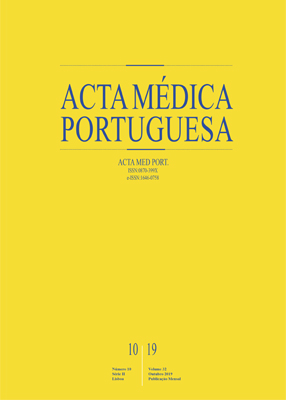Venous and Lung Thromboembolism in the Context of Lung Cancer: Clinical Manifestations, Risk Factors and Prognosis
DOI:
https://doi.org/10.20344/amp.10260Keywords:
Lung Neoplasms, Pulmonary Embolism, Venous ThromboembolismAbstract
Introduction: The relationship between cancer and thromboembolic events has been known for a long time. Lung and venous thromboembolism are frequent complications of lung cancer and its treatment, being a great cause of morbidity and mortality. We pretend to establish the relationship between lung and venous thromboembolism and lung cancer, describe patient characteristics and analyze the impact in the survival and prognosis.
Material and Methods: It was a retrospective study. All research subjects were selected from lung cancer patients with a newly diagnosed lung and venous thromboembolism event admitted to Hospital S. João, between January 2008 and December 2013 and were followed until December 2014. Statistical analysis was performed with SPSS.
Results: From the search, we obtained 113 patients. The majority was male, smokers or ex-smokers, and adenocarcinoma was the most frequent histologic type, being diagnosed mostly in advanced stages. We noticed that the median time between lung cancer diagnosis and lung venous thromboembolism was 2.9 months. In 24 patients (21.4%), the lung cancer diagnosis occurred after the lung and venous thromboembolism event and in 86 patients (76.8%), it occurred before the event. After a median follow up of 1.4 months, 107 (94.7%) patients died, 1 (0.9%) was lost to follow-up and 5 (4.4%) were still alive. The median survival rate was 1.5 months.
Discussion: The diagnosis of lung and venous thromboembolism in patients with lung cancer is associated with bad prognosis. It occurs most frequently in patients with advanced disease, in the first months after lung cancer diagnosis and after beginning chemotherapy.
Conclusion: Disease progression is an independent predictor with negative impact in overall survival.
Downloads
Downloads
Published
How to Cite
Issue
Section
License
All the articles published in the AMP are open access and comply with the requirements of funding agencies or academic institutions. The AMP is governed by the terms of the Creative Commons ‘Attribution – Non-Commercial Use - (CC-BY-NC)’ license, regarding the use by third parties.
It is the author’s responsibility to obtain approval for the reproduction of figures, tables, etc. from other publications.
Upon acceptance of an article for publication, the authors will be asked to complete the ICMJE “Copyright Liability and Copyright Sharing Statement “(http://www.actamedicaportuguesa.com/info/AMP-NormasPublicacao.pdf) and the “Declaration of Potential Conflicts of Interest” (http:// www.icmje.org/conflicts-of-interest). An e-mail will be sent to the corresponding author to acknowledge receipt of the manuscript.
After publication, the authors are authorised to make their articles available in repositories of their institutions of origin, as long as they always mention where they were published and according to the Creative Commons license.









